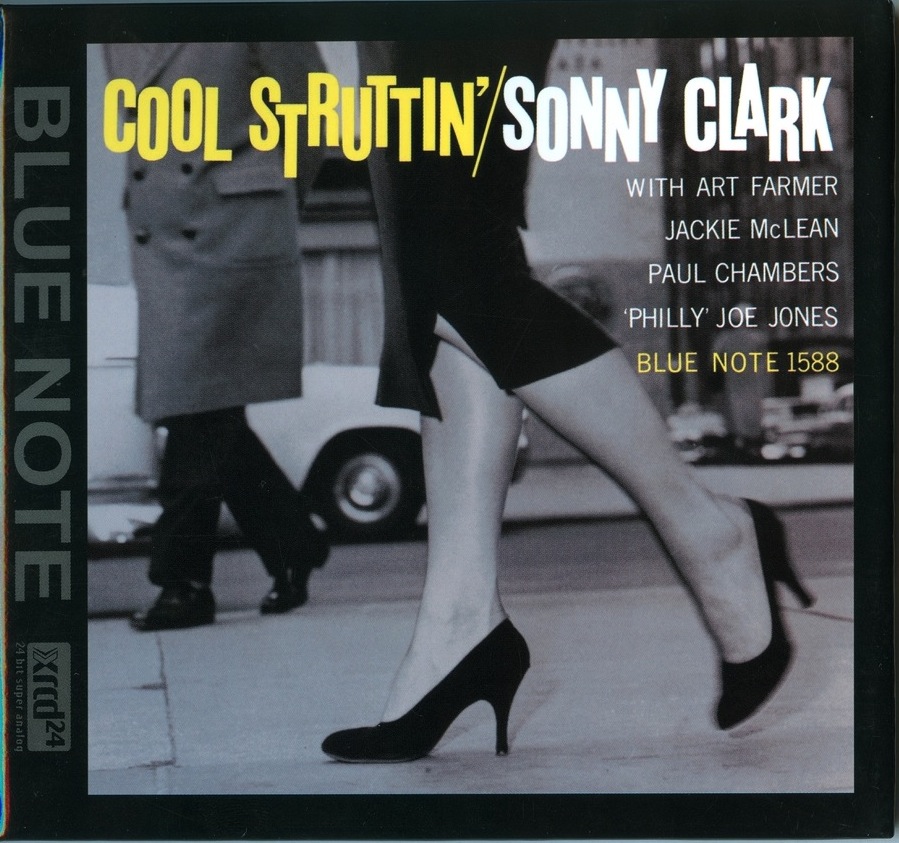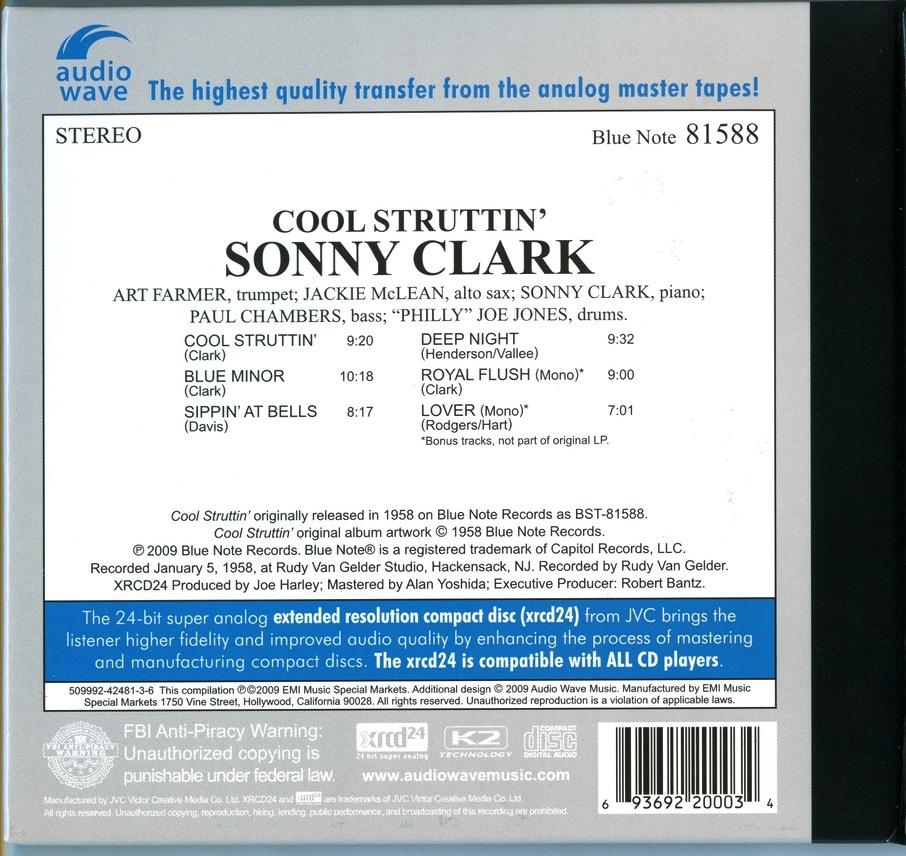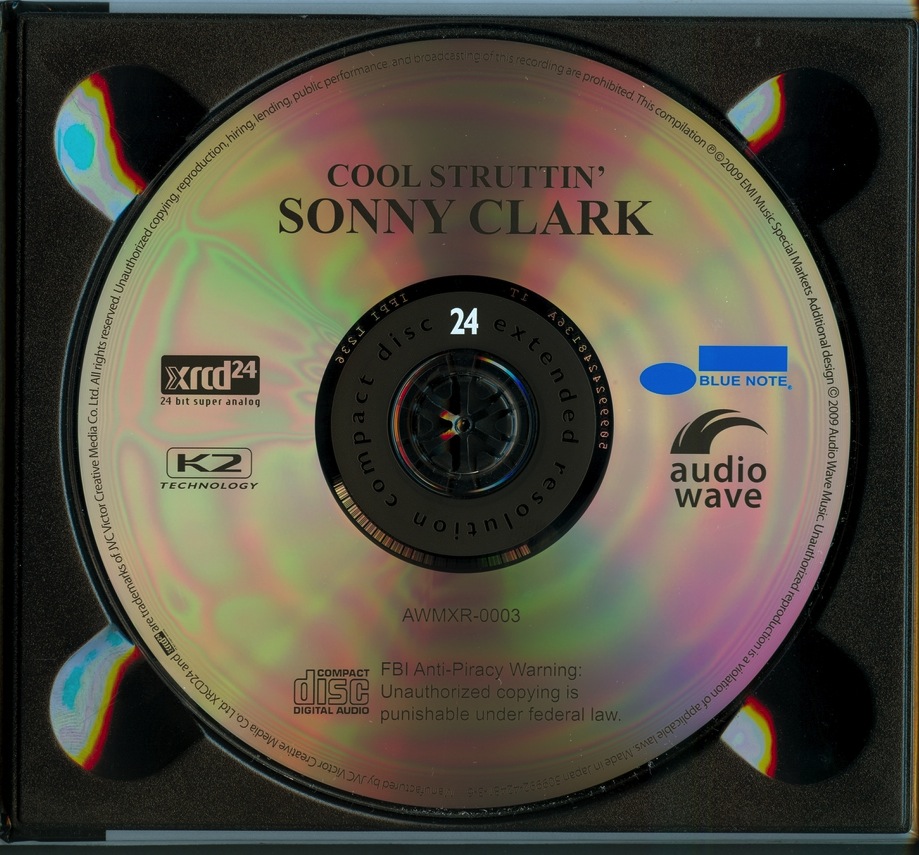


BOOKLET
Artist: Sonny Clark
Album: Cool Struttin’
Genre: Jazz
Styles: Hard Bop, Piano Jazz, Jazz Instrument
Item Number: AWMXR-0003
Brand/Label/Format: XRCD 24 Audio Wave/Blue Note
Recorded: 1958
Release Date: 2010
Tracklisting
1. Cool Struttin’
2. Blue Minor
3. Sippin’ At Bells
4. Deep Night
Bonus Tracks:
5. Royal Flush (Mono)
6. Lover (Mono)
Musicians:
Art Farmer (trumpet)
Jackie McLean (alto sax)
Sonny Clark (piano)
Paul Chambers (bass)
“Philly” Joe Jones (drums)
Features:
Mastered and produced by Alan Yoshida and Joe Harley from the Original Rudy Van Gelder Blue Note 2-Track Analog Tapes!
Highest Quality Analog-to-Digital transfers from tape to CD
Deluxe Packaging with Hi-Resolution Black & White Session Photos.
Includes Original Album Liner Notes
XRCD24 is Compatible with ALL CD PLAYERS!
Review
With the single exception of “Kind of Blue”, Sonny Clark’s “Cool Struttin”’ is almost certainly the coolest jazz album of all time. Whereas “Kind of Blue” gets its vibe from modal jazz, “Cool Struttin”’ depends mainly on the blues, relatively simple and straight ahead. Calling this ‘hard bop’ is correct but this does not do justice to the chemistry at work here. It is one of those rare recorded moments, as on “Kind Of Blue”, where everything is in a state of sublime balance, when the music making is made to seem so effortless that you could easily miss the brilliance of it all. The two albums were made within twelve months of each other.
The pairing of Art Farmer (trumpet) with Jackie McLean (alto sax) on “Cool Struttin'” is the second great contributor to the making of this great jazz album. They had played together in the mainly mainstream blues based Gene Ammons band for a number of years before the “Cool Struttin'” session and the rapport between them is noticeable. Art Farmer’s sophisticated trumpet sound is an excellent complement to Jackie McLean’s altogether more direct alto sound, drawing Jackie McLean more ‘inside’ than he was to be on almost any of his subsequent recordings. Their unison playing, breaking into occasional harmony, as on the title track or on “Blue Minor”, is the signature sound of the album.
And of course, Sonny Clark as leader sets the scene for all this magic to work. On the original vinyl album, he is composer on two tracks, “Cool Struttin'” and “Blue Minor”. Miles Davis’ “Sippin’ At Bells” and the non blues based Henderson/Vallee song “Deep Night” completed the album. From the same session, and for subsequent CD release, a further Sonny Clark composition, “Royal Flush”, together with the Rogers and Hart song “Lover” were added. The latter track has none of the qualities of the remainder of the album and is best dismissed.
Sonny Clark’s piano style has been often described as being influenced by Bud Powell. Yet as Johnny Griffin observed: ”Sonny was a little different. He used Bud’s basis for power and attack on the piano, but he had another finesse and an exceptional technique, too. He was quite himself.”
Little had been known about Sony Clark’s background until he had been interviewed by Leonard Feather for the sleeve notes of his Blue Note album, “Sonny Clark Trio”:
“I was born in a little coal mining town, about sixteen miles southeast of Pittsburgh, called Herminie, Pa. – population about 800. I was raised there till I was twelve, then lived in Pittsburgh until I was nineteen, just turning twenty; then an older brother, who plays piano, took me out to the (West) Coast to visit an aunt.
“Originally I only intended to stay a couple of months. I worked with Wardell Gray and all the fellows around the Coast. Then Oscar Pettiford came to town and we got a band and went to San Francisco.
“I worked in San Francisco a couple of months. Buddy DeFranco was in town, with Art Blakey, and Kenny Drew on piano and Gene Wright on bass. Then Blakey and Kenny Drew left him and I joined, along with Wesley Landers, a drummer from Chicago ..this was late in 1953 ”I stayed with Buddy quite a long while after we went back to the Coast. We made another tour, in the middle West, and we went to Honolulu. Altogether I was with Buddy about two-and-a-half years. Then in January, 1956, I joined Howard Rumsey’s Lighthouse All-Stars in Hermosa Beach, California and spent the whole year of 1956 there .
“The fellows out on the West Coast have a different sort of feeling, a different approach to jazz. They swing in their own way.
But Stan Levey, Frank Rosolino and Conte Candoli were a very big help; of course they all worked back in the East for a long time during the early part of their careers, and I think they have more of the feeling of the eastern vein than you usually find in the musicians out West. The eastern musicians play with so much fire and passion.
“We did concerts and a lot of record dates, and I could have stayed as long as I liked, but I wanted to see the East again, and also wanted to see my people who still live in Pittsburgh – a brother and two sisters – and a sister in Dayton. I got to see all of them by joining Dinah Washington in February, 1957 and going along with her as accompanist more or less for the ride.
“Since settling down in New York, I’ve been doing mostly recording.”
From 1957 he had become Alfred Lion’s preferred piano player. Appearing on seven Blue Note albums as leader and as a sideman on this and other labels, he played behind such influential figures as Sonny Rollins, Hank Mobley, Charles Mingus, Grant Green, Curtis Fuller, Johnny Griffin, Clifford Jordan, Lee Morgan, Tina Brooks, Bennie Green, Ike Quebec, Stanley Turrentine and Dexter Gordon.
Yet, during his short life (he died of a heroin overdose in 1963 aged just 31), Sonny Clark achieved little fame, little recognition.
It was during the “dark” days for jazz in the ’70s when fusion and rock had all but completely displaced mainstream jazz that the re-evaluation of Sonny Clark’s legacy began, not in the US or in Europe but in Japan. Jazz coffee shops (jazz kissa) had fostered a strong interest in hard bop. Rare Blue Note and Milestone albums became much sought after as collector’s items (“treasure albums”). And “Cool Struttin'” was as sought after as a “treasure album” as it was a firm favorite in the jazz kissas. As Blue Note Japan cottoned on and began re-releasing Sonny Clark albums, his music gradually became available once more to collectors in the US and Europe so that when the mainstream jazz revival of the ’80s began, Sonny Clark’s position as one of the great hard bop innovators was established.
It is fitting that Sony Clark is remembered as one of the generous sprits of jazz whose playing opened up the music to so many fine collaborations in his tragically shortened career. It is also fitting that “Cool Struttin'” is still being enjoyed around the world as the quintessential hard bop album.
Detailed Description
The Definitive Versions of Blue Note are on XRCD24… Listen & Compare!
Considered one of the great young pianists of the mid-to-late 1950s, Sonny Clark was practically the house pianist at Blue Note during 1957-62 before his premature death in 1963. He led seven albums for Blue Note during that time, appeared on many dates as a sideman, and recorded Cool Struttin, which is considered his main classic. Clark never recorded an unworthy chorus. His playing was full of joyful discoveries, constant swing, and an optimistic creativity that was indescribable and quite infectious. On Cool Struttin from 1958, Clark matches wits and inventive ideas with altoist Jackie McLean and trumpeter Art Farmer. Their four lengthy performances, which include Miles Davis Sippin’ At Bells and the exotic Deep Night, are filled with magical moments where the five musicians seem to think and create like one. The greatest jazz performances include moments like those heard on Cool Struttin , where the music has a life of its own beyond the individual players. The more one plays Cool Struttin , the more it is obvious that this is one of the truly essential Blue Note recordings.
